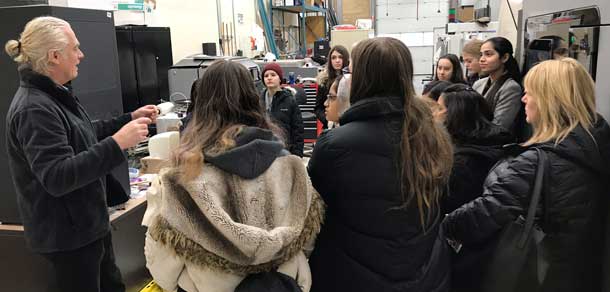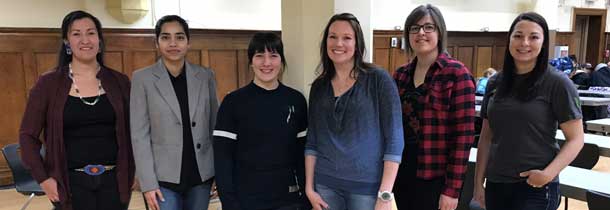Program heads discuss the many innovative programs, including 3D printing lab and related technologies at the Girls In The Classroom Trades and Technology Exploration event in Saskatoon.
Deb Shewfelt, M.Sc., P.Geo, grew up in oil and gas country along the border of the Saskatchewan potash basin. As a young girl she watched several men from her hometown of Birtle, MB make the daily drive to work across the provincial border into Saskatchewan’s southeast mining corridor. Though she was unaware these world-class natural resources held promise for her future career.
“For some reason, I didn’t even know about geoscience,” she said. “I didn’t know about geology or that it was a legit career opportunity that I would later discover as my life’s passion at the University of Manitoba. I wish I would have had female mentorship to support the awareness of geoscience earlier in my educational journey.”
“I was fortunate to find my calling – but what if I hadn’t stumbled upon it? I can’t imagine my life now without the great satisfaction that I have working as a geologist in Western Canada.”
That memory was something that inspired Shewfelt to introduce Girls in the Classroom – Unearthing Career Opportunities in Mining, an educational outreach project that engages elementary and high school girls.
The aim of the project is to raise awareness around unconventional STEM-related career opportunities in the mining and mineral sector through unique engagement with exemplary women from the industry.
“It is an easy assumption to make that, of course, young women know about mining and these diverse career opportunities in the province, but we still have a lot of work to do to promote the unconventional careers at which women are excelling,” said Shewfelt, a professional geoscientist with APEGS, EGM (MB) and NAPEG (NWT and Nunavut) and senior geoscientist, co-president and director of RESPEC Consulting Inc. in Saskatoon. Shewfelt also volunteers on the APEGS Student Development Committee, where she champions student-industry engagement.
“Mining and all of the supporting industries are such a major part of our economy. We need to continue to advise and support the consideration of this sector by female students and Indigenous youth.”
Shewfelt says the heart and soul behind the Girls in the Classroom program is career awareness, to highlight non-conventional STEM (science, technology, engineering and mathematics) careers through living examples of women working in this sector and debunking stereotypes about what kind of careers women can or should have.
“Top to bottom, Saskatchewan is such a geological wonder. It makes sense for us to stay and work here in this province and to attract other people to come and work here,” she said. “Yes, we do need more women working in these careers. We need more diversity on our teams.”
Shewfelt received funding to launch the two-year pilot program from the International Minerals Innovation Institute. While the pilot phase concluded on Dec. 31, 2019, Shewfelt has been asked to plan several 2020 events and hopes to gain further support from industry, education, government or other like-minded organizations to make these events happen.
She has enjoyed engaging with similar projects, such as the WIM/WIN SK mentorship program, MentorSTEP, as well as the Women’s Mentorship Luncheon series, put on jointly by The Ron and Jane Graham School of Professional Development, U of S College of Engineering and APEGS 30by30 committee. Shewfelt is also involved as a mentor in these programs and has recruited women from these programs to support the Girls in The Classroom initiatives.
An example of one the projects undertaken by Girls in the Classroom over the past two years was ‘Forces and Simple Machines’ for Grade 5 students and ‘Rocks, Minerals and Erosion’ for Grade 4 students.
Before their work on forces and simple machines, the students learned about various rocks, minerals and erosion. The students investigated elements of these three things as well as how they connect to Saskatchewan’s land and economy, industry and environmental sustainability.
The students welcomed a female geologist from industry to the classroom who introduced her education and career path and showed them elements of mining in Saskatchewan. The students were shown pictures and videos of different machines that are used to dig, haul and clean ore from different forms of mining.
Saskatchewan Polytechnic alumni female volunteers from various programs, including electrical, chemical technology, mining engineering technology and GIS, supported the Girls in The Classroom Trades and Technology Exploration event at the Saskatoon campus.
For a final project, the students were asked to combine the thinking of these ideas and building a machine that could be used in the mining industry.
Assisting Shewfelt with this program are women who have carved careers in the mining and minerals professions. They volunteer their time to connect with teachers and students to share their stories and experiences and connect these themes to the Saskatchewan Public School curriculum, with hopes of inspiring the next generation.
Several women from Saskatchewan companies like Cameco, BHP and K+S Potash gave their time to the program, as have educators from the University of Saskatchewan College of Engineering and Saskatchewan Polytechnic.
“It’s women like that who we want to hold up as great role models for these young women to aspire to and use their unique skill sets as a woman to really help support and enhance STEM in general.”
“Most of what I do comes from a desire to open young minds about what a career in mining can look like. Women have significant, diverse and relevant ideas to share and the mining and minerals sector knows it.”
The industry has made strides in diversifying its workforce from leadership roles to underground mining. Jessica Theriault, P.Eng. in 2019 wrapped up her term as chair of the board of directors for the Saskatchewan Mining Association. It was the first time in its 50-plus-year history the association had a female chair. Karen Swager is the first female potash business unit senior vice-president.
The women who volunteer for the Girls in the Classroom program also highlight the courses in high school that are pre-requisites and post-secondary training avenues to explore. Inspiring and mentoring youth, in particular female and Indigenous students, and encouraging them to explore a career in STEM is a goal of the Girls in the Classroom initiative. Its premise is targeted at that demographic, but Shewfelt admitted she gets a lot from the program as well.
“There’s a huge satisfaction in sharing your story and potentially inspiring someone else,” she said. “You’re being a mentor in an informal way. How can I help somebody find their unique path? If our stories help girls and young women discover their passion, in particular one that they had not previously considered, then we’ve succeeded.”

